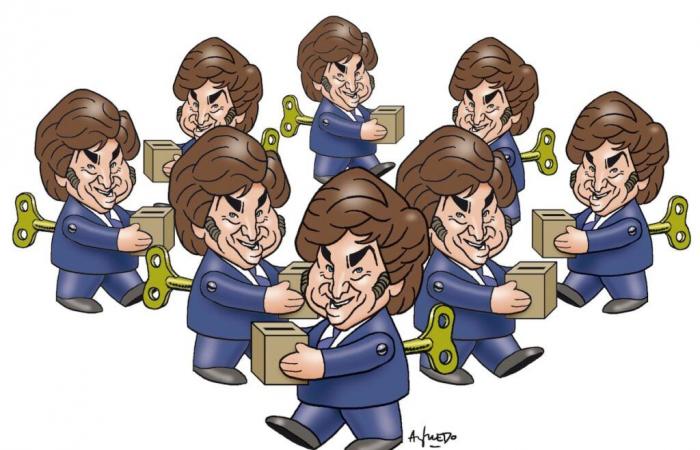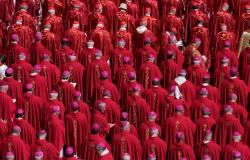Are they or are made? That is the new quid of the political issue in this election year: if the anger that the president star Javier Milei And some of his key ministers in recent weeks is an electoral tactic or speaks of a Mileista soul. The two things are possible. On the one hand, Legislative election forces mileism to compete without Milei: A fire test that faces for the first time in his short party life puts pressure on the ruling party and leads him to activate all the political ammunition at his disposal. Without Milei as a candidate, the need to make everything is imposed, and all the candidates: “Adorni is Milei” is one of the central slogans in the city. A tactic that spreads in other territories, even the farthest from the political war by AMBA.
“We are Javier Milei in Misiones,” posted the first deputy candidate for La Libertad advances in that province, the stock market producing agent Diego Hartfield. He accompanied him with an image generated by AI in the purest style of his political driver, which shows the continuous transmutation of Hartfield in a imposing hair and roar lion: worth seeing. Curious, even more than the images of AI with which the president entertains: Sanmartinian skins or inspired by various, real or fictional sagas, to exhibit his authority. Sobriety is not fashionable in politics and is not just a phenomenon of Mileista Argentina: United States and Donald Trump vibrate with the same wave and the same resources. But That absence is even more exposed when the smaller policy characters go up to the same record. The death of the superego among the libertarians is abounded: he entertains them. But not only that: at the same time, consolidates its most identity electoral base, Copa the public conversation and agitates the mood of its political enemies. This opposition indignation adds to the daily confrontation with which the ruling holds alive the flame of his boldness. With that logic, they aim to win the elections in X, in principle.
In politics, 2025 represents Phase 2 of Mileista governance, a mileism without Milei that is capable of winning elections. Phase 1 was to reach the presidency, to govern with the same in the most absolute minority and have recognized macroeconomic successes. In phase 2 there are risks for Milei, also for Argentina. The greatest protection coat of electoral defeat is expected: the economy. In that sphere, from the government they already imagine the soon landing of phase 4: the rollover of public debt, according to the title of an economic column of Hartfield itself, with lower costs and better deadlines. Meanwhile, the preparation for this scenario is followed within phase 3, with the stimuli that seek to recapitize the economy without generating inflation and impacting growth. The advances of Luis Caputo About the de facto bimonetarization of the economy go on that side: a decolchoize Argentina to release the use of dollars and implement consumption and production.
The questions accumulate at that point, waiting for the government to officially officiate these measures and give details. independent economists see it with expectation. The most institutionalists are concerned two things: the officialization of informality and opacity of the origins of those dollars. To the most practical, to what extent the ark will turn a blind eye.
The idea is this: the easiest toad to swallow is the bleaching of a gray economy, but the hardest to swallow is the consolidation of an economy based on the purest illegality, with money from the narco or corruptionFor example. To others more “ñoños”, according to the libertarian language, the lack of coherence, that is, the loss of intertemporal confidence that implies jumping from a money laundering approved by Congress and with costs for bleaching to another, a year later, decided discretionally from the Executive Power and No awards logic for which he fulfilled tax and some cost for which it was delayed to laundering. We must wait for the small print of the measures to understand the rationality of Caputo’s advances.
In politics, phase 2 is several things. Milei fully in the campaign, with presence in one of the scenarios of the national territory. Besides, The nationalization of each subnational proposal: chainsaw, the downward inflation and exit of the stocks such as the identity of the political vision, no matter what province it is. And confrontation to the umpteenth power as another face of tactical pragmatism. The choice of journalism as a favorite enemy in recent weeks is the countercase of a sustained weakness of the political opposition. For mileism, neither as a corporation nor in their individualities, politicians are political enemies of sufficient weight to take advantage of them in the campaign. We must add other enemies: economists, artists or journalists. Each corporation has a role in the Mileista electoral strategy.
Last year the political question was: do you see it? It was applied to anyone who was no officialist already his misunderstanding of a macroeconomic arcane and popular representation that Mileism believes to interpret better than anyone. The electoral result proved him in relation to his ability to represent. The economic result accompanies the government even in very complex areas that have always been the beginning of the crisis of Argentine governments: for example, the issue of the exchange rate.
From the Mileista of the Cepo, the movement of the dollar generates more peace of mind than uncertainty. At the calm of the downward inflation, the government managed to add a flotation between quiet bands. There are those who predict that Chicha is calm: there will be storms due to the appreciation of the weight, they maintain. Do you see it? They don’t see it, the libertarians say.
Now the question – are they or do? – falls on the government and the folds of their political project: Is there a dream of a thriving macroeconomy at the expense of some kind, more or less serious, of institutional weakness? There fits the question of the Mileista soul. The way in which mileism has been to whip journalism in a broad sense, or personalizing arbitrary attacks or arming arguable lists of reprobes journalists falls within that question.
Journalists are not heroes but independent journalism, which takes distance from power, has a role in democratic machinery: make visible what power wants to hide. Because power, by definition, is opaque, and in some cases, very dark. By definition, that is the place of journalism in the most strict and interesting sense. The role of research journalism during Kirchnerism makes it clear.
At times, Milei’s confrontational logic with journalism does not point to his improvement, but ends up registering in himself mode of operation than Kirchnerism. Those who relativize the tone of the Mileistic questions minimize them by comparing them with the extremes of Kirchnerism: the tightening of journalists via AFIP, the secret pressures to the writings or direct threats.
Milei did not send anyone to jail. That’s true. It is also true that what these voices forgive Milei would not have forgiven Kirchnerism. Generating that double rod is a problem for Milei and Argentina: A clear example of the pendulum, which never stays still at one end. In that mechanics, the risk is to return the opposite end.
Mileista confrontation is part of a global current political governance manual. But in the case of Milei’s management, there is a point where it seems to lose meaning: the flow of economic achievements that it has to show could be electorally useful to consolidate and expand citizen support. In a less confrontative society and cornered by the polarization encouraged from power, the calm economy would be an unquestionable electoral fact for less radicalized citizenship. In 2024, the greatest support for Milei was given in that discovery of the vital harmony that brought down inflation. Instead, confrontation intensifies basic identity but remains support for support. To the most independent corner.
Macro rationality versus institutional rationality: the choice in the city is a witness case of that dilemma. On May 18, Buenos Aires Republican Antikirchner and its institutionalist disposition, which gave the identity and triumph to Pro for so many years, will be tested. Within the Porteña center quadrant, the equation to be elucidated is this: If in the city, the libertarian candidate is imposed on the PRO candidate means that the Republican Utopia of Pro loses in the bastion where that value was stronger, in addition to Córdoba.
“Argentina backed Argentina from 2004 or 2005, when everything was forgave Nestor Kirchner. The same thing happens with Milei,” they describe with realism, or resignation, from a sector of the ProTeño campaign. Why not take advantage of institutionalist identity just when Milei is intensifying his game to the edge of democracy, although from the inside, as Milei himself explained? “Nobody wants Milei to raye,” they recognize in that sector. In that political reading, we had to wait until the crisis of the field in 2008 so that citizens and opposition were aware and put limits: the Milei government is still young for the awareness of those alerts. He did not find his own field crisis yet.
The risk of a government like the Mileista is to be incubating over low heat its own future limits, just for a management that needs its future reproduction to guarantee the full development of the macroeconomics with which it dreams. The intensity of the confrontation always runs the risk of ending up becoming citizen fed up.






